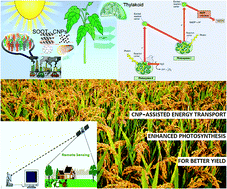Optical emission diagnosis of carbon nanoparticle-incorporated chlorophyll for sensing applications
Abstract
Chlorophyll fluorescence (Chl F) is widely used in sensing applications to understand terrestrial vegetation and environmental and climatic variations. The increasing rates of industrialization and carbon emission from internal combustion engines (ICEs) pose a threat to sustainable development. This study analyses the impact of carbon nanoparticles (CNPs) from ICEs on the optical absorption and fluorescence emission of leaf pigments. Leaf pigments without and with CNPs were subjected to UV-visible and photoluminescence (PL) spectroscopy analyses. The field emission scanning electron microscopy and high-resolution transmission electron microscopy images of CNPs showed their morphology. The Jablonski diagram of the CNP-incorporated chlorophyll system helped in understanding the fluorescence emission, internal conversion, and the exchange of energy between them. The variations in (i) total chlorophyll, (ii) optical absorbance by total chlorophyll, (iii) PL emission peak (at 675 nm and 718 nm) intensities for different excitation wavelengths, and (iv) normalized absorbance at the PL emission peaks with different CNP concentrations were analysed by dividing into three regions. In Region I (0–0.625 mg ml−1), the radiative component dominated the nonradiative component as a result of energy transfer from CNPs to chlorophyll. In Region II (0.625–1.2 mg ml−1), the increase in CNP concentration initiated diffusion into chloroplasts, resulting in the increase in the nonradiative part of total energy and decrease in PL peak intensity. In Region III (1.2–2.5 mg ml−1), the energy absorbed by the CNPs dissipated more nonradiatively, leading to a slow rate of increase in the radiative part. The visual response of PL emission, color purity, and the distribution of the emitted energy over the spectrum studied with the help of CIE plots, power spectrum, and confocal fluorescence microscopy revealed the fluorescence emission in the red region. This study suggests the possibility of employing Chl F in agricultural, environmental, and biological fields for sensing applications.



 Please wait while we load your content...
Please wait while we load your content...